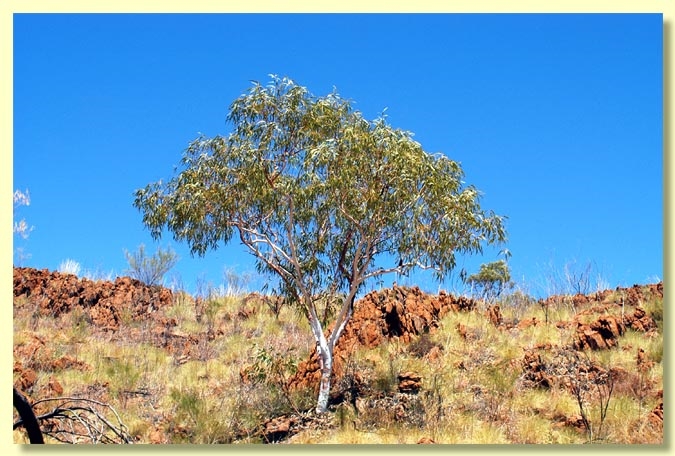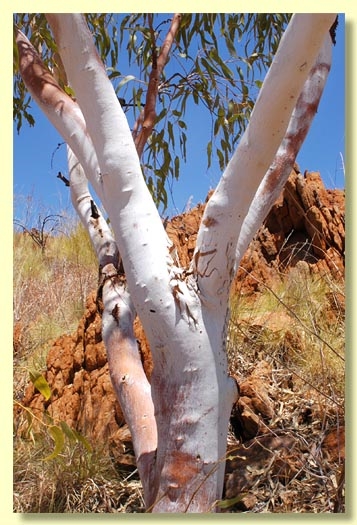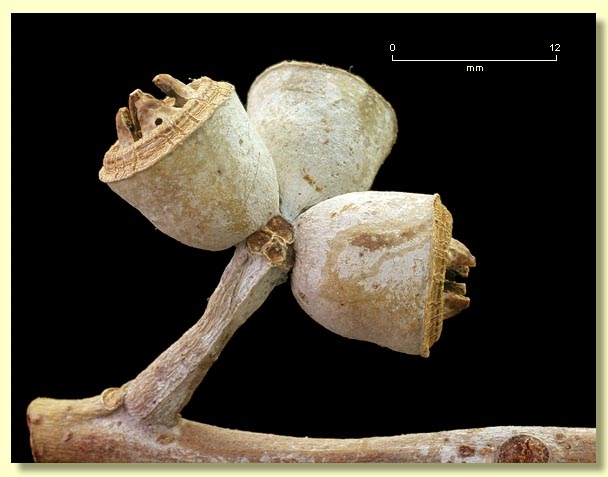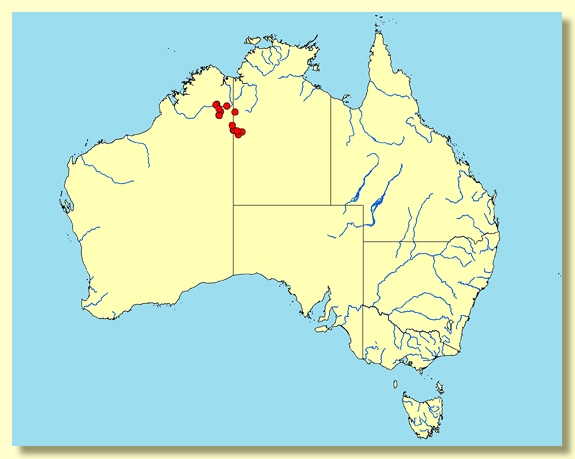Euclid - Online edition
Eucalyptus cupularis
Eucalyptus | Symphyomyrtus | Exsertaria | Subexsertae | Pyramidales
Eucalyptus cupularis C.A.Gardner, J. & Proc. Roy. Soc. W. Australia 47: 60 (1964).
T: Halls Creek, Western Australia, 11 May 1951, C.A.Gardner 10217; holo: PERTH; iso: BRI, PERTH.
Small tree to ca 8 m tall, often of poor form. Forming a lignotuber.
Bark smooth and powdery throughout, new bark pale pink, maturing to white. Branchlets glaucous.
Juvenile growth (coppice or field seedlings to 50 cm): stems square in cross-section; juvenile leaves petiolate, alternate, ovate, 8–14 cm long, 4–8 cm wide, base rounded, blue-grey to glaucous.
Adult leaves alternate, petiole 1.5–3.5 cm; blade narrowly lanceolate to lanceolate, sometimes falcate 10–23 cm long, 0.9–2.7(3.5) cm wide, base tapering to the petiole, margin entire, apex pointed, concolorous, dull green to grey-green, side-veins acute or at a wider angle than 45° to the midrib, reticulation very dense, intramarginal vein present, oil glands obscure.
Inflorescence axillary unbranched, peduncles (0.7)1–2 cm long, buds per umbel 7, usually sessile, rarely shortly pedicellate (pedicels 0–0.3 cm long). Mature buds obovoid to diamond-shaped, 0.75–1.4 cm long, 0.4–0.9 cm wide, at times weakly angled basally, glaucous, scar present, operculum rounded to conical (0.5–0.6 cm long), sometimes shortly apiculate, stamens irregularly flexed or with some outer stamens erect and the inner ones inflexed, anthers oblong, versatile, dorsifixed, dehiscing by longitudinal slits, style long and straight, stigma blunt, locules usually 4, the placentae each with 6 or more vertical rows of ovules. Flowers white.
Fruit sessile to shortly pedicellate (pedicels 0–0.1 cm long), cup-shaped to obconical, 0.5–1.2 cm long, 0.7–1.2 cm wide, usually glaucous, disc weakly raised to level, valves 4, strongly exserted.
Seeds brown, 1–1.7 mm long, ± obliquely pyramidal to cuboid, dorsal surface shallowly reticulate, ventral surface ribbed, edge of seed sharply toothed, hilum terminal.
Cultivated seedlings (measured at ca node 10): cotyledons bilobed, stem square or rounded in cross-section, glaucous or non-glaucous; leaves always petiolate (petioles 0.5–0.8 cm), opposite for 4 to 9 nodes then alternate, ovate, 5.5–14 cm long, 1.3–7 cm wide, base tapering to the petiole, dull grey-green to glaucous.
Flowering has been recorded in October and November.
A small tree from the Kimberley region of Western Australia, from the Bedford Downs – Bungle Bungle National Park region, south through Halls Creek to just crossing the border into the Gardner Range area of the northern Tanami region of the Northern Territory. It prefers growing on the foothills of low hills or on seasonally flooded, low lying areas or along drainage lines or watercourses. Characterised by the smooth white powdery bark, the glaucous branchlets, the distinctly petiolate, concolorous, dull green, lanceolate adult leaves and the relatively large glaucous buds and fruit, the fruit with prominently exserted valves.
Eucalyptus cupularis belongs to a small group of species closely related to the red gums. This group is distinguished by having smooth powdery bark, adult leaves with dense to very dense reticulation and intersectional or absent oil glands, buds with incurved or erect stamens, fruit with a weakly raised to annular disc and obliquely pyramidal, toothed seeds with a ± terminal hilum. Other members of this group are E. mooreana, E. pantoleuca, E. herbertiana, E. glomericassis and E. gregoriensis.
Within this group, E. cupularis is closest to E. herbertiana and E. gregoriensis. It differs from both by having slightly larger buds and fruit (the fruit usually 0.7 cm or wider in E. cupularis and 0.6 cm or narrower in E. herbertiana and E. gregoriensis). It is distinguished further from E. herbertiana by having glaucous branchlets, buds and fruit (E. herbertiana only rarely with slightly glaucous buds), and from E. gregoriensis by having seven-budded umbels and peduncles longer than 0.6 cm (E. gregoriensis normally with three-budded umbels and peduncles shorter than 0.5 cm). It is distinguished from E. glomericassis by having dull green to grey-green adult leaves and a relatively narrow disc on the fruit (E. glomericassis with glossy green adult leaves and a broad disc). It is easily distinguished from the other two members of the group, i.e. E. mooreana and E. pantoleuca, by its adult leaf shape and position. E. cupularis has petiolate, lanceolate, alternate adult leaves while E. mooreana has sessile, opposite, elliptical to ovate adult leaves and E. pantoleuca has petiolate, ± opposite, orbicular to deltoid adult leaves. E. pantoleuca is further distinguished by having three-budded umbels.
Within its area of occurrence, E. cupularis may be confused with other related white gums; i.e. E. alba var. australasica, E. apodophylla, E. bigalerita, E. brevifolia, E. confluens, E. houseana, E. ordiana and E. rupestris.
E. cupularis differs from E. alba var australasica by having glaucous branchlets, buds and fruit (the branchlets, buds and fruit in E. alba var. australasica not glaucous). E. brevifolia and E. confluens can be distinguished by having fruit with a broad flat disc and valves that are near the rim or only slightly exserted. (The fruit in E. cupularis has a disc that is annular and not broad and has prominently exserted valves.) E. confluens can be further separated by having glossy adult leaves (always dull in E. cupularis). E. apodophylla is distinguished by having opposite to sub-opposite, sessile to shortly petiolate adult leaves and fruit with the valves near the rim or only slightly exserted (E. cupularis with alternate, distinctly petiolate adult leaves and fruit with prominently exserted valves). E. bigalerita should not be confused with E. cupularis as it has large, deltoid to orbicular adult leaves and is, more often than not, with salmon-coloured smooth bark. E. houseana is distinguished by having smaller fruit, usually 0.5 cm or narrower and by having the valves of the fruit near the rim or slightly exserted (the fruit of E. cupularis is 0.7 cm or wider and the valves are prominently exserted). E. ordiana is separated by usually having glaucous to blue-grey, broad ovate to ± deltoid leaves in the mature crown (E. cupularis with dull green to grey-green lanceolate leaves in the mature crown). E. rupestris has shorter, ± ovate adult leaves, normally shorter than 8 cm, and small, cylindrical fruit, 0.4 cm or narrower, while E cupularis has lanceolate adult leaves, normally longer than 10 cm, and cup-shaped fruit, normally 0.7 cm or wider.
Eucalyptus cupularis: Latin cupula, a little cup, referring to the fruit shape.














